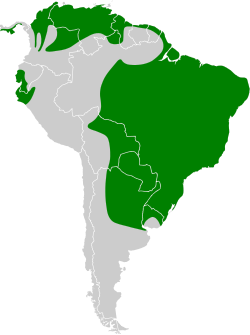From Wikipedia
Open on Wikipedia
| Savanna hawk | |
|---|---|

| |
| In the Pantanal, Brazil | |
| Scientific classification | |
| Kingdom: | Animalia |
| Phylum: | Chordata |
| Class: | Aves |
| Order: | Accipitriformes |
| Family: | Accipitridae |
| Genus: | Buteogallus |
| Species: | B. meridionalis
|
| Binomial name | |
| Buteogallus meridionalis (Latham, 1790)
| |

| |
| Synonyms | |
|
Heterospizias meridionalis | |
The savanna hawk (Buteogallus meridionalis) is a large raptor found in open savanna and swamp edges. It was formerly placed in the genus Heterospizias. It breeds from Panama and Trinidad south to Bolivia, Uruguay and central Argentina.[2] There are also reports of it in California, from 1973 in Alameda County and from 1974 in San Diego County.[3]
Description
[edit]
The savanna hawk is 46–61 cm (18–24 in) in length and weighs 845 g (29.8 oz).[4] The adult has a rufous body with grey mottling above and fine black barring below. The flight feathers of the long broad wings are black, and the tail is banded black and white.[2][4] The legs are yellow. The call is a loud scream keeeeru.[4]
Immature birds are similar to the adults but have darker, duller upperparts, paler underparts with coarser barring, and a whitish supercilium. This species perches very vertically, and its legs are strikingly long.[4]
Food and feeding
[edit]The savanna hawk feeds on small mammals, small birds, lizards, snakes, toads, frogs, eels, other fish, crabs, roots, spiders, and large insects (such as grasshoppers).[5][6][7] It usually sits on an open high perch from which it swoops on its prey, but will also hunt on foot, and several birds may gather at grass fires.[2]
Reproduction
[edit]The nest is of sticks lined with grass and built in a palm tree.[2] The clutch is a single white egg, and the young take 6.5 to 7.5 weeks to fledging.[4]
References
[edit]- ^ BirdLife International (2020). "Buteogallus meridionalis". IUCN Red List of Threatened Species. 2020 e.T22695832A168793019. doi:10.2305/IUCN.UK.2020-3.RLTS.T22695832A168793019.en. Retrieved 19 November 2021.
- ^ a b c d Sabrina Ramirez (2014). "Buteogallus meridionalis (Savanna Hawk)" (PDF). University of the West Indies. Archived (PDF) from the original on June 28, 2017. Retrieved June 27, 2017.
- ^ "EBird Checklist - 21 Sep 1974 - Tijuana River Valley--west of Hollister - 71 species (+4 other taxa)". 21 September 1974.
- ^ a b c d e Hilty, Steven L (2003). Birds of Venezuela. London: Christopher Helm. p. 236. ISBN 0-7136-6418-5. Retrieved June 27, 2017.
- ^ "Buteogallus meridionalis (Savanna Hawk)" (PDF). Sta.uwi.edu. Retrieved 26 March 2022.
- ^ "Savanna Hawk | the Peregrine Fund".
- ^ Ferguson-Lees, J. & Christie, D.A. & Franklin, K. & Mead, D. & Burton, P.. (2001). Raptors of the world. Helm Identification Guides.
Additional sources
[edit]- ffrench, Richard (1991). A Guide to the Birds of Trinidad and Tobago (2nd ed.). Comstock Publishing. ISBN 0-8014-9792-2.
- F. Gary Stiles; Alexander Frank Skutch (1989). A guide to the birds of Costa Rica. Comstock Publishing. ISBN 0-8014-9600-4.
External links
[edit]- Savanna hawk videos on the Internet Bird Collection
- Savanna hawk photo gallery Archived 2011-06-14 at the Wayback Machine VIREO
